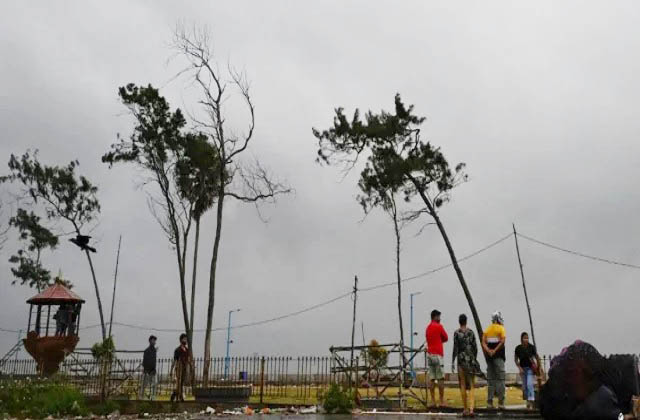
Cyclone Dana, which formed in the Bay of Bengal, made landfall on the coast of Odisha, India on Thursday.
There were significant concerns about the potential damage it could cause in Odisha and West Bengal.
Meteorologists had warned of the risk of severe flooding along Bangladesh’s coast due to the cyclone’s proximity.
The Meteorological Department had forecasted a storm surge of two to three feet above normal in at least 14 coastal districts of Bangladesh.
Despite the anxiety generated by Dana in India and Bangladesh, the cyclone was not as destructive as anticipated.
It made landfall in the Kendrapara area of Odisha, leading to some rain and gusty winds in coastal regions, but there were no reported casualties.
In various areas of West Bengal, including Digha, there were reports of heavy rain and strong winds; however, damage was minimal.
While it was predicted that Kolkata would experience winds up to 80km/h, actual wind speeds did not exceed 40km/h.
The Bangladesh Meteorological Department (BMD) had warned that the front of the powerful cyclone could lead to coastal districts such as Satkhira, Khulna, Bagerhat, Barguna, Barisal, Jhalakathi, Pirojpur, Patuakhali, Bhola, Lakshmipur, Noakhali, Feni, Chittagong, and Cox’s Bazar, as well as nearby islands and low-lying areas, being inundated by two to three feet of storm surge above normal tides.
The department also indicated that heavy (44 to 88mm) to very heavy rainfall (over 89mm) could occur in coastal areas and adjacent islands and chars.
In reality, however, only 25km/h winds were recorded in Mongla, causing a few trees to fall in some coastal areas, but nothing beyond that.
The cyclone was not as strong as expected due to at least six reasons mentioned by meteorologists in Bangladesh.
Limited extent of the cyclone
According to Muhammad Abul Kalam Mallik from the BMD, the first reason is that Dana had a limited extent.
The cyclone was confined to a small area.
The larger the extent of a cyclone, the more significant its impact. This was not the case with Dana.
Presence of anticyclones
The second reason for Dana’s reduced impact was the presence of two active anticyclones in the region when the cyclone made landfall—one in central India and the other extending from Myanmar to the northeastern Bay of Bengal.
Meteorologists said that these anticyclones allowed dry air to enter Dana’s path, leading to a rapid loss of strength.
Low moisture content
Abul Kalam Mallik explained that the primary fuel for a cyclone is moisture.
A higher moisture content results in a more powerful cyclone; however, Dana had a low amount of moisture.
Wind speed differences
The difference between the wind speed above the cyclone and the surface speed can also affect its strength.
If the difference is significant, the cyclone’s strength diminishes.
In Dana’s case, the difference in wind speed and surface speed was large, preventing it from becoming particularly strong.
Weak cloud formation
The sixth reason for Dana’s limited strength was that its ability to form deep convective cloud systems was relatively weak.
Dana began to weaken immediately after making landfall on the Odisha coast, which is why areas like Bangladesh were largely spared from its impacts.
Unique characteristics of cyclones
Abul Kalam Mallik said that typically, one cyclone does not share characteristics with another; each cyclone has its unique attributes.
Despite being classified as “strong,” Cyclone Dana could not achieve significant strength due to its inherent weaknesses.
As a result, both Indian and Bangladeshi coastal areas experienced minimal damage.


